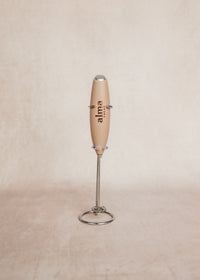Provide additional details about the offer you're running.
So. What is Ceremonial Cacao?
In simple terms, cacao is not just a drink—it’s a potent, mood boosting ritual in a cup. Ceremonial cacao is 100% pure, minimally processed cacao paste, traditionally used in indigenous ceremonies and now embraced for its powerful benefits for our bodies, brain, and heart.
Don’t be fooled—this is not ordinary hot chocolate. Ceremonial cacao is both an ancient tradition and a modern superfood. It’s a rich and deeply nourishing medicine for modern times.
In this guide, we’ll explore the roots of cacao, what makes it ‘ceremonial’, all the different ways you can use it, and why it’s quickly becoming the cornerstone of the wellness world. Strap yourselves in: this is your Cacao 101.
What Makes Cacao 'Ceremonial-Grade'
If you’re anything like us, your first question might be: what exactly makes it "ceremonial"?
Well, here’s the truth: there’s no official definition. With no regulatory standards in place in the cacao industry, it comes down to the honesty and integrity of the people making it. That means not every cacao branded as "ceremonial" lives up to the name. Put simply–not all cacao is created equal.
At Alma Cacao, after time spent living and learning in Guatemala, here’s what ceremonial cacao means to us:
-
Purity: It must be 100% organically grown and unprocessed. No sugar, no additives, no dairy. The beans should ideally come from a single farm, or at the very least the same region.
-
Process: Every step in the process should be done by hand using traditional methods passed down for generations. Proper fermentation, slow drying, gentle toasting — these aren’t just technicalities; they’re essential for preserving the natural compounds that give cacao its magic.
-
Intention: This is harder to define but impossible to ignore. The reverence and presence of those growing, preparing, and serving the cacao matter as does the intention you hold when you drink it. We've felt the difference, and we know you will too.
In short - for cacao to be truly ceremonial grade its all about how it was grown (using organic, regenerative and low impact methods), how it was made (handcrafted using ancestral techniques, untempered and unprocessed) and finally the less physically tangible but equally important intention behind why it was made.
Ceremonial cacao is typically sold as a solid paste (not powder), made from whole ground cacao beans. It retains all its natural fats and minerals, unlike cocoa powder which is heavily processed, heated at high temperatures and stripped of its natural theobromine fatty butter–and stripped of its benefits in the process
So, when we talk about ceremonial-grade cacao vs cacao vs cocoa, we’re talking about a world of difference — in taste, texture, integrity, and impact.
Not all cacao is created equal. At Alma, our cacao is grown in the highlands of Guatemala by a women-led Mayan collective. Every bar is crafted with care, respect, and tradition — and you can taste (and feel) the difference.
The Origins and History of Ceremonial Cacao
Ceremonial cacao has deep roots in ancient Mesoamerica, where the Mayans and Aztecs honoured cacao not just as food, but as a sacred plant spirit—a divine bridge between the physical and spiritual realms.
Among the Mayan people, cacao was used in ceremony, initiation, and daily ritual alike—offered to deities, shared in sacred rites, and consumed in preparation for vision quests, weddings, and funerals. Its sacredness was woven into the fabric of life. The word ka’kau appears in ancient Mayan texts alongside depictions of gods pouring cacao from great heights to create a frothy, ceremonial drink
For the Aztecs, cacao was equally revered. In fact, cacao beans were so highly valued they were used as currency — traded for goods and services, and often more valuable than gold. A single cacao bean could buy a tamale; a hundred might get you a turkey. Only the elite — priests, warriors, and nobility—typically drank cacao, and it was believed to bestow strength, clarity, and divine insight.
The name Theobroma cacao, meaning "food of the gods," was later coined by the Swedish botanist Carl Linnaeus, but it echoes what these civilisations knew all along: cacao wasn’t just nourishing to the body—it was medicine for the soul
Importantly, these ancient cultures didn’t separate the physical and the spiritual as modern society tends to. Cacao was food, medicine, offering, and communion all at once. It was a plant that opened the heart and sharpened the mind—used to connect with the divine, with the land, and with one another.
Today, modern cacao ceremonies often draw inspiration from these ancestral traditions—combining indigenous wisdom with contemporary practices of mindfulness, somatic healing, and personal transformation. While the settings may have changed, the essence remains the same: to slow down, to connect, and to listen deeply.
The Benefits of Ceremonial Cacao
What makes Alma Cacao so unique isn’t just its rich flavour or ancient traditions—it’s the powerful combination of a trio of very special compounds which naturally occur in very high quantities only found in cacao. It is the potent combined relationship between Theobromine, Anandamide and Phenylethylamine working together to create a deeply nourishing mind-body experience which lies at the heart of Cacao’s unique effects as a superfood for the mind, body, heart and (spirit!).
Radiant health perks rounded up:
-
Nutrient-rich goodness: loaded with magnesium, iron, flavanols, and antioxidants that help reduce inflammation and support overall wellbeing.
-
Gentle, sustained energy: thanks to theobromine, which sharpens focus and boosts circulation without gripping caffeine jitters.
-
Mood-enhancers at work: anandamide and PEA help lift mood, open the heart, and support emotional balance.
-
Holistic health in every sip: linked with better cognitive function, cardiovascular health, gut support, and even skin vitality—ceremonial cacao offers benefits you can feel (and science is beginning to affirm)
Curious for the full deep dive? You’ll find an extended breakdown of ceremonial cacao benefits over on our health benefits page.
How to Use Ceremonial Cacao
There are so many different ways to enjoy ceremonial-grade cacao and we’re not here to tell you what’s right and whats wrong.
Ceremonial cacao is incredibly versatile.
To enjoy cacao as a drink is the most common way to consuming this superfood. You can take a look at our personal preparation guide here to learn how to prepare the perfect cup of cacao.
For daily use: We recommend 15-25g of cacao paste added to hot coconut milk.
For ceremonial use: Use higher doses (42g+) and prepare with presence. Set an intention, slow down, and connect. This kind of dose is great for journaling, creative practice, meditation and breathwork.
Cacao can also be added to smoothies, raw desserts, or enjoyed as a rich sipping chocolate. In the summer we have loads of fun making creamy coconut iced cacao lattes!
Ceremonial-grade cacao is a potent superfood and can be a powerful medicine—it's not just another wellness trend.
How to Choose Quality Ceremonial Cacao
Not all cacao is created equal. If you want to experience the true depth, flavour, and benefits of ceremonial cacao, there are a few key things to look out for:
- Grown in one place, not blended with beans from different regions. This preserves the unique flavour profile and energetic quality of that land.
- Stone-ground, poured, and set with care, not processed in industrial machinery. The difference isn’t just in taste, it’s in the spirit of the cacao.
- Grown without harmful chemicals and with respect for the farmers, their communities, and the environment.
- Only one ingredient. Just 100% pure cacao paste, as it’s been enjoyed for thousands of years.
Red flags? Beware of industrial cacao powders being sold as "ceremonial," products with added sweeteners or flavourings, or brands that aren’t transparent about where and how their cacao is grown and made.
At Alma, we've tried to keep things simple—and slow. Our cacao is handmade in Guatemala by a women’s collective using traditional techniques passed down through generations. It’s single-origin, 100% organic, and ethically traded at well above the local wage. Some things simply can’t be rushed and are worth paying more for.
Common FAQs About Ceremonial Cacao
Is ceremonial cacao the same as raw cacao?
Not quite. Ceremonial cacao is gently toasted (not raw) to preserve its active compounds. Raw cacao often lacks the depth and warmth of ceremonial-grade.
Can I drink ceremonial cacao every day?
Yes! Lots of people drink a small-moderate dose daily to support focus, energy and mood. 15-25g is a good ballpark for a daily dosage.
Does ceremonial cacao have caffeine?
Cacao contains theobromine — a cousin to caffeine that offers energy without the crash.
Is cacao safe during pregnancy?
Generally speaking - Yes. That said, everyone is different, so we always recommend checking with a healthcare professional.
Check out our full FAQs sections for more answers to the post common cacao questions!
Ceremonial cacao isn’t just a wellness trend. It’s an invitation to slow down, connect, and return to something ancient and true.
Whether you’re new to cacao or deepening your practice, we invite you to explore Alma Cacao — pure, powerful, and rooted in respect.
Discover: Alma Beginner Bundle
Read: How to Prepare Ceremonial Cacao
Learn: More About Our Story
From our hearts to yours—welcome to the cacao journey




